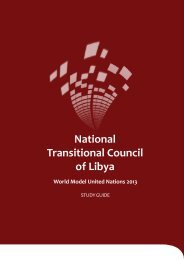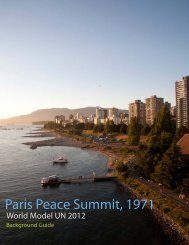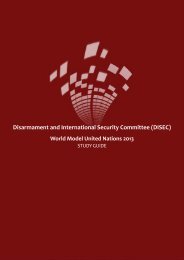Social, Humanitarian and Cultural Committee (SOCHUM)
Social, Humanitarian and Cultural Committee (SOCHUM)
Social, Humanitarian and Cultural Committee (SOCHUM)
You also want an ePaper? Increase the reach of your titles
YUMPU automatically turns print PDFs into web optimized ePapers that Google loves.
people living on $1 per day, but the indigenous groups<br />
within their borders will not. 182 Because indigenous<br />
peoples do not make up a large percentage of the<br />
total population of many countries, the levels of<br />
various development indicators achieved by these<br />
countries are hardly affected by worse statistics for<br />
indigenous communities. That should not be taken<br />
to mean, however, that the economic development<br />
of indigenous communities should not be a priority<br />
for national governments. Many policies aimed at<br />
reducing poverty <strong>and</strong> hunger to the targets set in the<br />
first MDG do not reach indigenous peoples <strong>and</strong> do<br />
not take their specific needs <strong>and</strong> circumstances into<br />
account. 183 Any plan to achieve true success with the<br />
Millennium Development Goals will have to include<br />
special policies designed specifically for indigenous<br />
peoples.<br />
the importance of targeting indigenous peoples for<br />
achieving the MDGs becomes evident by examining the<br />
progress of nations <strong>and</strong> their indigenous populations<br />
toward various MDG targets. Two types of countries<br />
emerge through this analysis. The first are countries<br />
that are on track to achieve certain MDG targets but<br />
have indigenous minorities that will not reach the<br />
same level of improvement. Minorities in Vietnam,<br />
for example, have poverty rates 40% higher than<br />
the majority ethnic population. Mexico, a member<br />
of the Organisation for economic Co-operation <strong>and</strong><br />
Development (OECD), is likely to reach almost all<br />
of the MDG targets, but the region of Metlatonoc,<br />
which is 98% indigenous, has development indices<br />
comparable to Malawi <strong>and</strong> Angola, two of the most<br />
underdeveloped countries in Sub-Saharan Africa. 184<br />
the second category of countries are those that are<br />
not going to reach some of the MDG targets because<br />
of their indigenous minority groups, including many<br />
African nations like Cameroon, Mali, <strong>and</strong> Senegal.<br />
In Niger, for example, 29% of children experienced<br />
nutrition deprivation in 2006, a figure that was<br />
elevated due to the 33% <strong>and</strong> 30% rates among the Peul<br />
<strong>and</strong> tuareg minority populations. 185 these statistics<br />
make it clear that more must be done to specifically<br />
target indigenous peoples in order to achieve the<br />
MdGs for all segments of the population.<br />
Many people working toward improving the<br />
situation for indigenous peoples believe that the<br />
framework of the MDGs needs to be altered if we<br />
hope to achieve the MDG targets among indigenous<br />
populations. Firstly, the MDGs do not explain the<br />
need to address indigenous groups differently.<br />
Because of this, national development policies do<br />
not take indigenous groups into account. A survey of<br />
MDG reports from various nations shows that 68% of<br />
countries’ plans do not respond to the special needs<br />
of indigenous peoples, <strong>and</strong> many do not even mention<br />
the existence of indigenous peoples at all; additionally,<br />
when indigenous populations are mentioned in these<br />
reports, it is almost exclusive in the sections about<br />
the second MDG, which concern universal primary<br />
education. 186,187 As shown above, general statistics<br />
on MDG progress make the condition of indigenous<br />
peoples invisible. Secondly, the desire to achieve<br />
the MdG targets has encouraged some countries to<br />
take actions that harm their indigenous populations,<br />
like increased mining efforts in the Philippines <strong>and</strong><br />
seizing of pastoral l<strong>and</strong>s for agriculture in Kenya. 188<br />
thirdly, the MdGs are not framed in a human rightsbased<br />
way, meaning that they do not take into<br />
consideration the fact that a population cannot make<br />
significant developmental progress if they do not<br />
have basic human rights. It is impossible to talk about<br />
reducing hunger, for example, without first ensuring<br />
that everyone has secured his or her right to food. 189<br />
Finally, the MDGs are enumerated as development<br />
targets <strong>and</strong> do not take account for the structural<br />
causes of poverty, including discrimination <strong>and</strong> a lack<br />
of indigenous civic involvement as discussed above. 190<br />
Reflecting on the way that the MDGs have been<br />
43<br />
Melbourne Host Directorate PTY LTD | Office of Media <strong>and</strong> Design

















